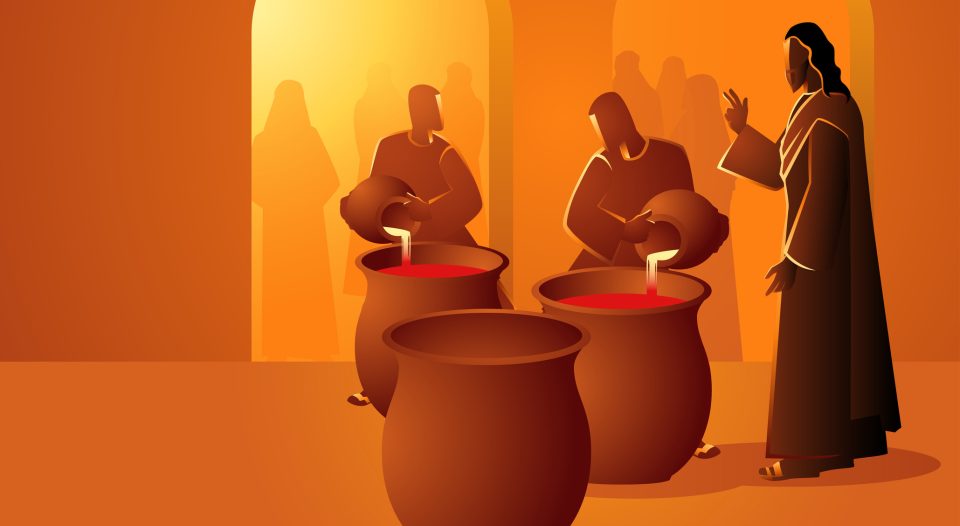Lectionary for Jan. 19, 2024
Second Sunday after Epiphany
Isaiah 62:1-5; Psalm 36:5-10;
1 Corinthians 12:1-11; John 2:1-11
Have you ever tried to give a persuasive presentation? Maybe you were trying to move a romantic relationship to the next level. Maybe you were trying to land a contract or a deal for work. Sometimes we make a presentation to one person; at other times we make it to many people, trying to convince them of different things at the same time. The latter happened when my nieces made Canva presentations about what they wanted for Christmas. In their presentations, they noted the good options that my wife and I could buy for them, but they also had sections for their grandparents and parents. My nieces know an aunt and uncle commitment to gifting isn’t the same as a parent gift, so they created their presentations knowing that we would respond differently based on our relationship.
In this week’s Gospel passage, Jesus makes a presentation to multiple audiences at once.
After the introduction, the first large section of the Gospel of John is referred to as the “Book of Signs.” Jesus performs miraculous signs that are meant to, all at once, confirm his identity as the Word and Light who has come into the world. The turning of water into wine at Cana was one such sign that he performed for many audiences at once.
The first audience was Jesus’ newly recruited disciples. Andrew, another unnamed disciple, Simon Cephas, Philip and Nathanael had only been following Jesus for a few days when they were invited to a wedding with their new master. Apparently, Jesus gaining disciples was a big enough deal that they were invited to the festivities as a set. Some of his few disciples had witnessed Jesus’ baptism at the hands of John, others had simply engaged him in speech and found him convincing. Jesus turned water to wine specifically to be a sign to reveal his glory and to help his disciples believe in him. It worked (John 2:11)!
The servers at the party were the next audience for Jesus’ sign. The Gospel is specific about who knows what in the process of Jesus’ miracle. Mary (we’ll return to her shortly) commanded the servants to go to Jesus and obey him. Jesus could have simply created wine any number of ways. The one who can multiply fishes and loaves could have multiplied what remaining wine was left. Instead, he had the servants fill six containers with about 20 gallons of water each.
Jesus turned water to wine specifically to be a sign to reveal his glory and to help his disciples believe in him. It worked!
Hauling water, if you’ve never done it, is slow, heavy work. You have to get it from a source—a lake, river, well or cistern. If the water was for ritual washing (6), the preference would have been for “living water” from a moving source such as a river. So the servants hauled more or less 120 gallons of water and filled the stone jars.
Jesus didn’t perform an elaborate show. He spoke no words. He didn’t dip his finger into the wine. Instead, he merely told the servants to take some of the liquid and bring it to the master of ceremonies, who didn’t know where the wine came from (and apparently didn’t consider asking the servant). But the servants knew (9). Jesus performed his sign for “the help.” They had hauled all that water and knew for sure it wasn’t wine. Until it was! The guests were already drunk, so there was no need (I don’t care how big your wedding is) for 120 gallons of wine. Jesus made wine so plentiful at this wedding that, of course, the servants were going to drink also—and they got the best stuff (10).
The last audience for Jesus’ sign was his mother, Mary. When she told Jesus that the party had run out of wine, she knew he would do something about it. She didn’t make a request but just informed Jesus (who liked to drink quite a bit—see Matthew 11:19, Luke 7:34) of the situation. Mary helped prepare the scene for others to learn what she and her other children already knew: Jesus could perform miracles because he had come from God. And after Jesus revealed his glory in the first of his signs, Mary and his brothers journeyed together with the Messiah and his disciples, staying together for several days (12).
Look, Jesus knows what we need to see and believe. God’s grace makes it possible for us to believe in the first place! With his new disciples, servants and family gathered around, Jesus performed the first of his miracles to show them all his glory. This same glory he shows to each of us, not just in saving a wedding feast, but in preparing us a feast in heaven, of which we are allowed foretastes even in these days!





